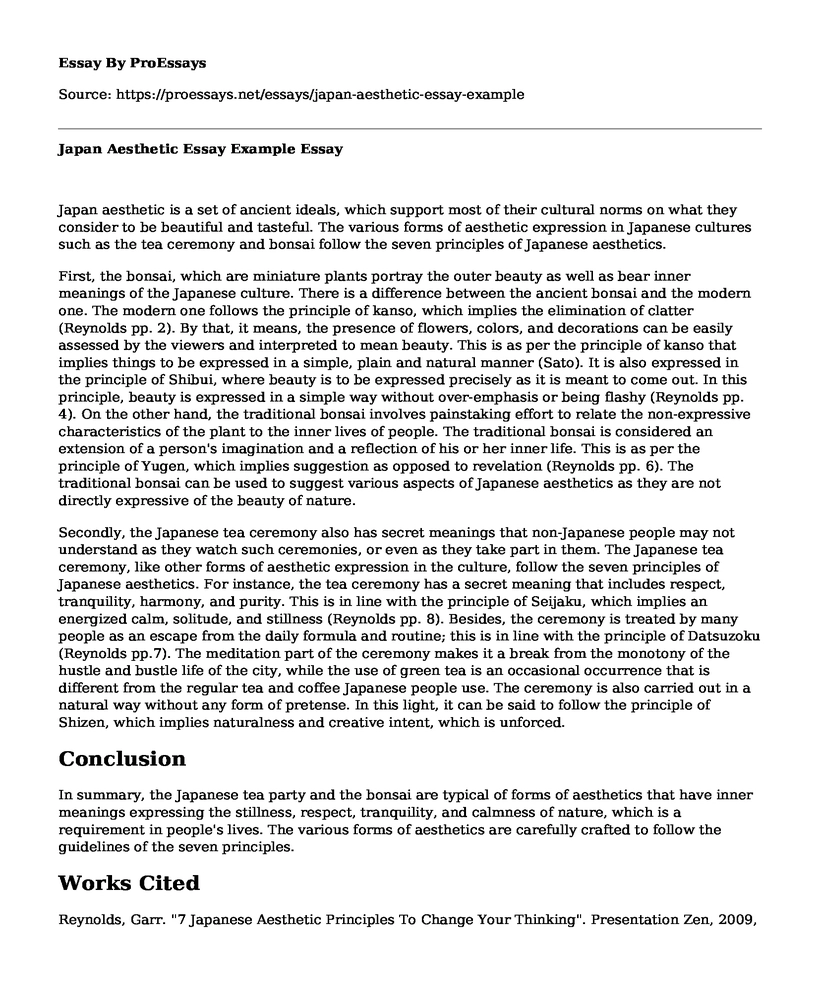Japan aesthetic is a set of ancient ideals, which support most of their cultural norms on what they consider to be beautiful and tasteful. The various forms of aesthetic expression in Japanese cultures such as the tea ceremony and bonsai follow the seven principles of Japanese aesthetics.
First, the bonsai, which are miniature plants portray the outer beauty as well as bear inner meanings of the Japanese culture. There is a difference between the ancient bonsai and the modern one. The modern one follows the principle of kanso, which implies the elimination of clatter (Reynolds pp. 2). By that, it means, the presence of flowers, colors, and decorations can be easily assessed by the viewers and interpreted to mean beauty. This is as per the principle of kanso that implies things to be expressed in a simple, plain and natural manner (Sato). It is also expressed in the principle of Shibui, where beauty is to be expressed precisely as it is meant to come out. In this principle, beauty is expressed in a simple way without over-emphasis or being flashy (Reynolds pp. 4). On the other hand, the traditional bonsai involves painstaking effort to relate the non-expressive characteristics of the plant to the inner lives of people. The traditional bonsai is considered an extension of a person's imagination and a reflection of his or her inner life. This is as per the principle of Yugen, which implies suggestion as opposed to revelation (Reynolds pp. 6). The traditional bonsai can be used to suggest various aspects of Japanese aesthetics as they are not directly expressive of the beauty of nature.
Secondly, the Japanese tea ceremony also has secret meanings that non-Japanese people may not understand as they watch such ceremonies, or even as they take part in them. The Japanese tea ceremony, like other forms of aesthetic expression in the culture, follow the seven principles of Japanese aesthetics. For instance, the tea ceremony has a secret meaning that includes respect, tranquility, harmony, and purity. This is in line with the principle of Seijaku, which implies an energized calm, solitude, and stillness (Reynolds pp. 8). Besides, the ceremony is treated by many people as an escape from the daily formula and routine; this is in line with the principle of Datsuzoku (Reynolds pp.7). The meditation part of the ceremony makes it a break from the monotony of the hustle and bustle life of the city, while the use of green tea is an occasional occurrence that is different from the regular tea and coffee Japanese people use. The ceremony is also carried out in a natural way without any form of pretense. In this light, it can be said to follow the principle of Shizen, which implies naturalness and creative intent, which is unforced.
Conclusion
In summary, the Japanese tea party and the bonsai are typical of forms of aesthetics that have inner meanings expressing the stillness, respect, tranquility, and calmness of nature, which is a requirement in people's lives. The various forms of aesthetics are carefully crafted to follow the guidelines of the seven principles.
Works Cited
Reynolds, Garr. "7 Japanese Aesthetic Principles To Change Your Thinking". Presentation Zen, 2009, https://www.presentationzen.com/presentationzen/2009/09/exposing-ourselves-to-traditional-japanese-aesthetic-ideas-notions-that-may-seem-quite-foreign-to-most-of-us-is-a-goo.html. Accessed 27 Nov 2018.
Sato, Joy Mari. Japanese Tea Ceremony: Tea at Koken with Sound. 2008, https://youtu.be/7tt7NBIVeMY. Accessed 27 Nov 2018.
Cite this page
Japan Aesthetic Essay Example. (2022, Oct 20). Retrieved from https://proessays.net/essays/japan-aesthetic-essay-example
If you are the original author of this essay and no longer wish to have it published on the ProEssays website, please click below to request its removal:
- Article Analysis Essay on "The Minoans of Crete"
- Schottische Dance Essay
- School Jazz Group Essay Example
- Essay Example on Should Women Balance Motherhood and Career?
- Beyonce: Queen of R&B Music - Essay Sample
- Balancing Career and Family: The Need for Attention - Essay Sample
- Culture Intelligence or Quotient Essay Example







